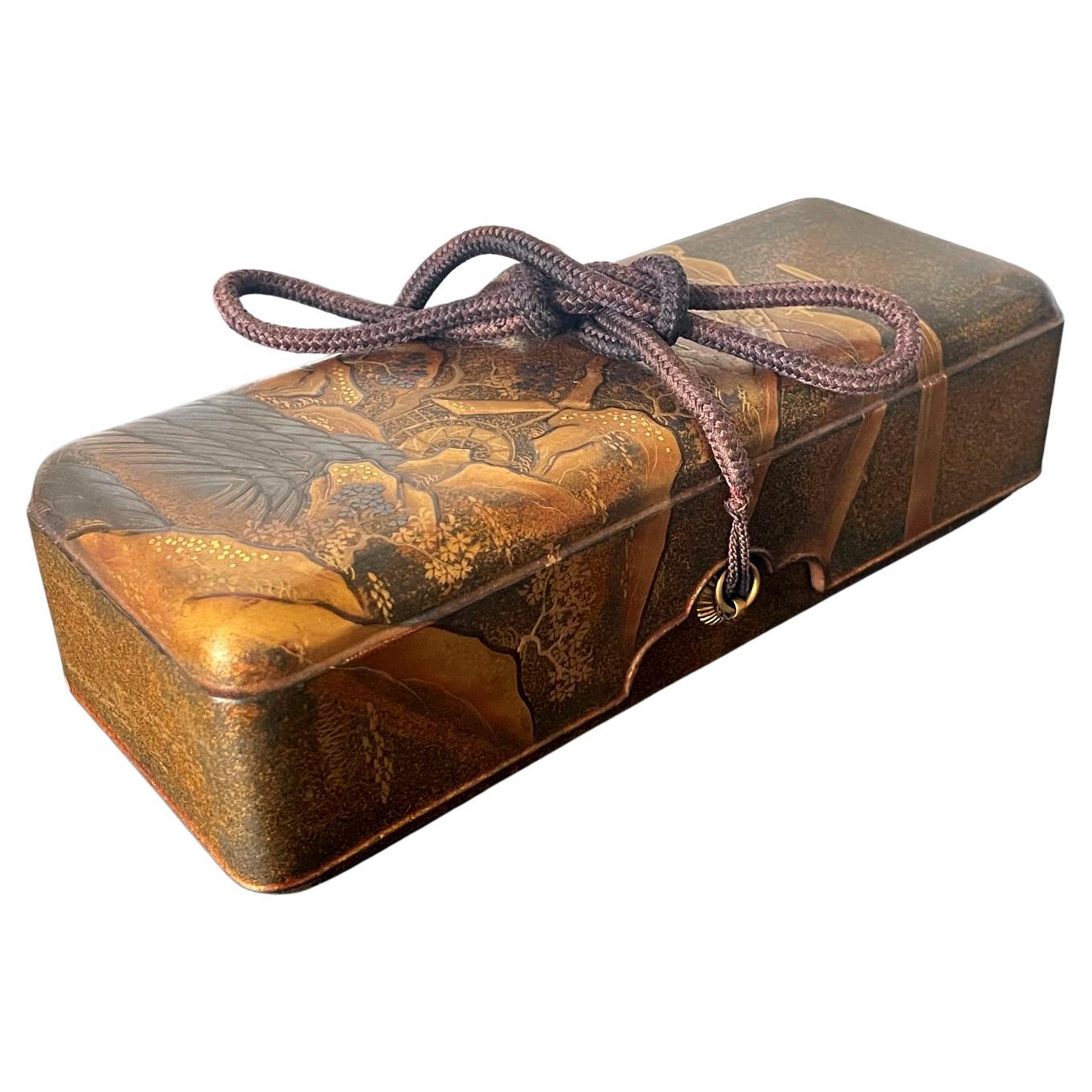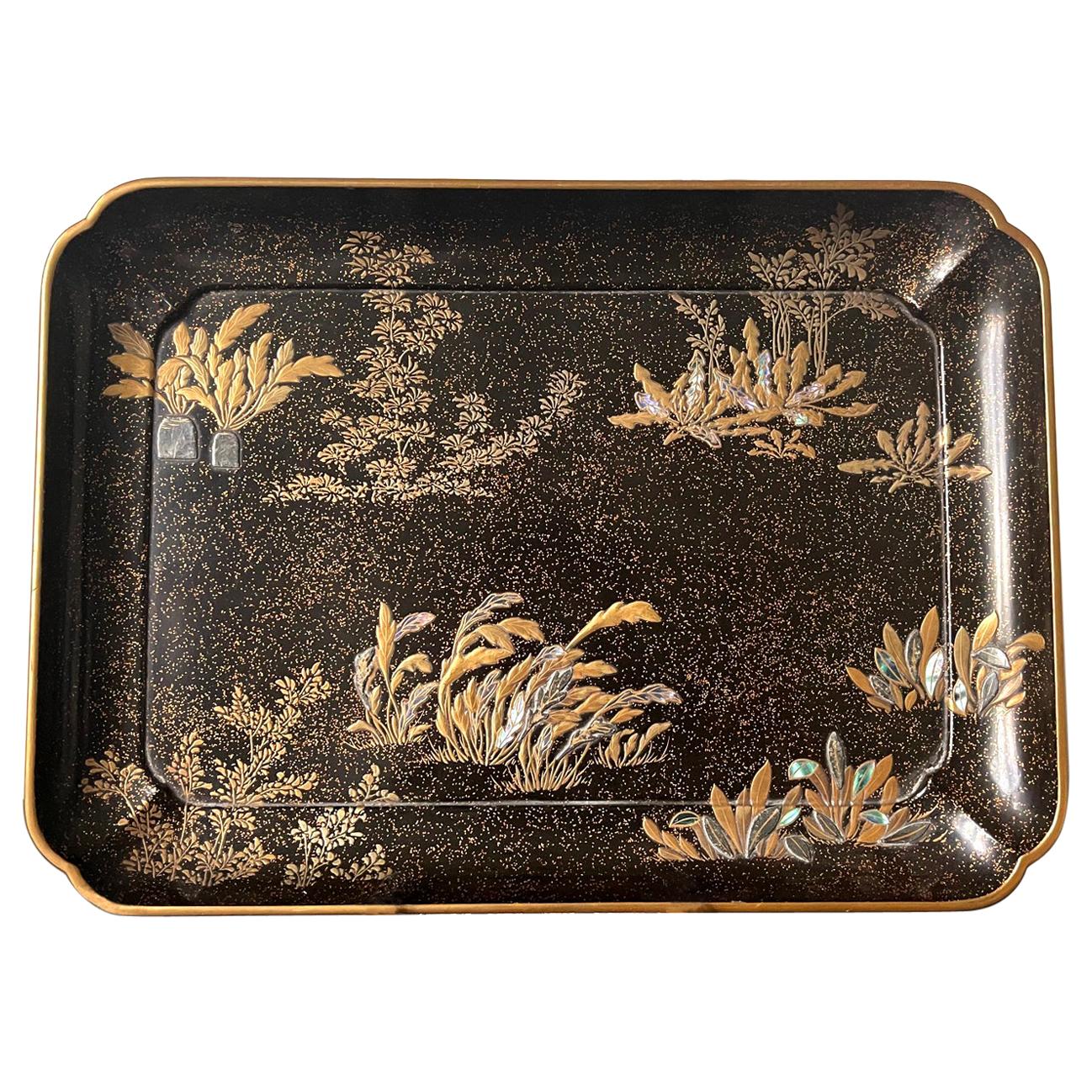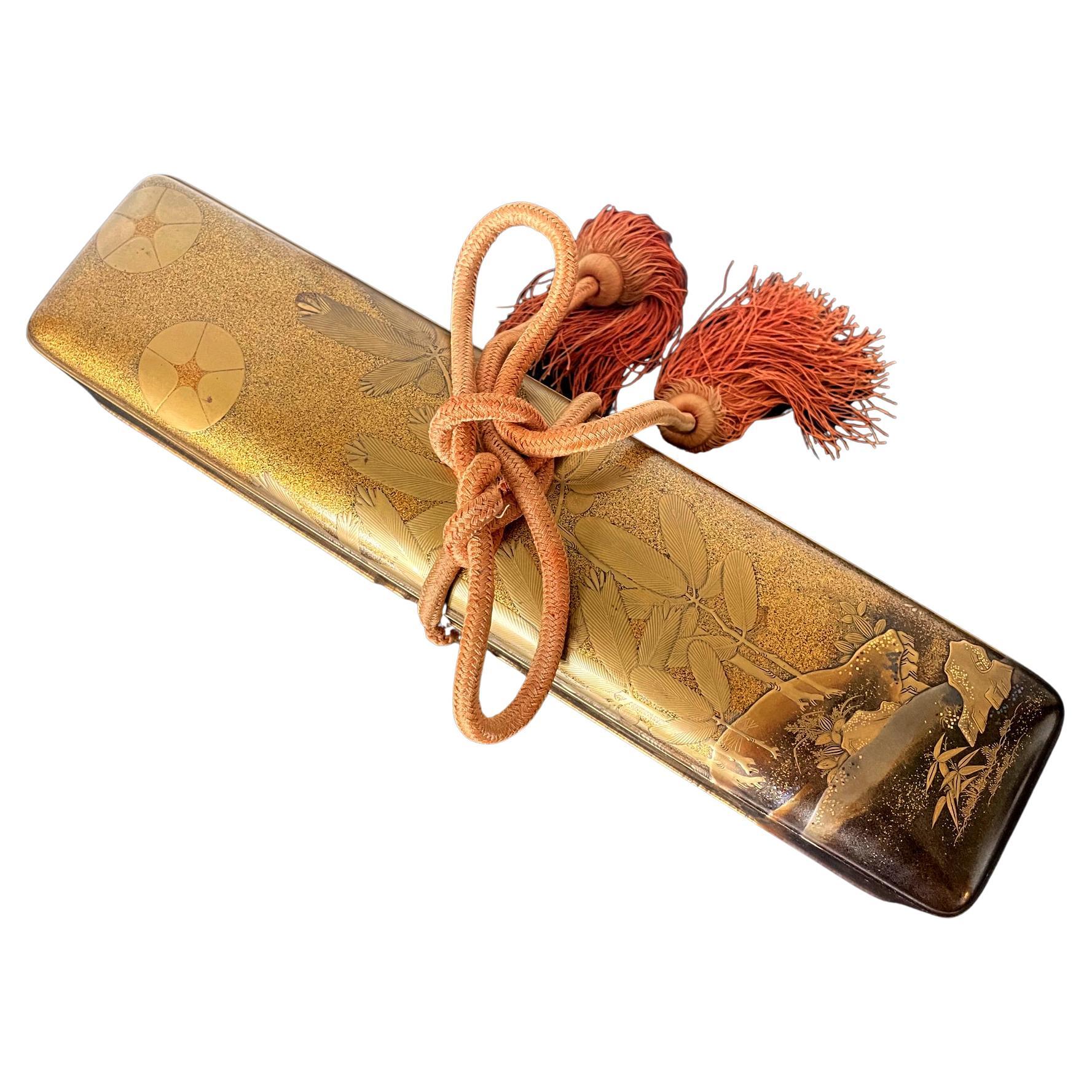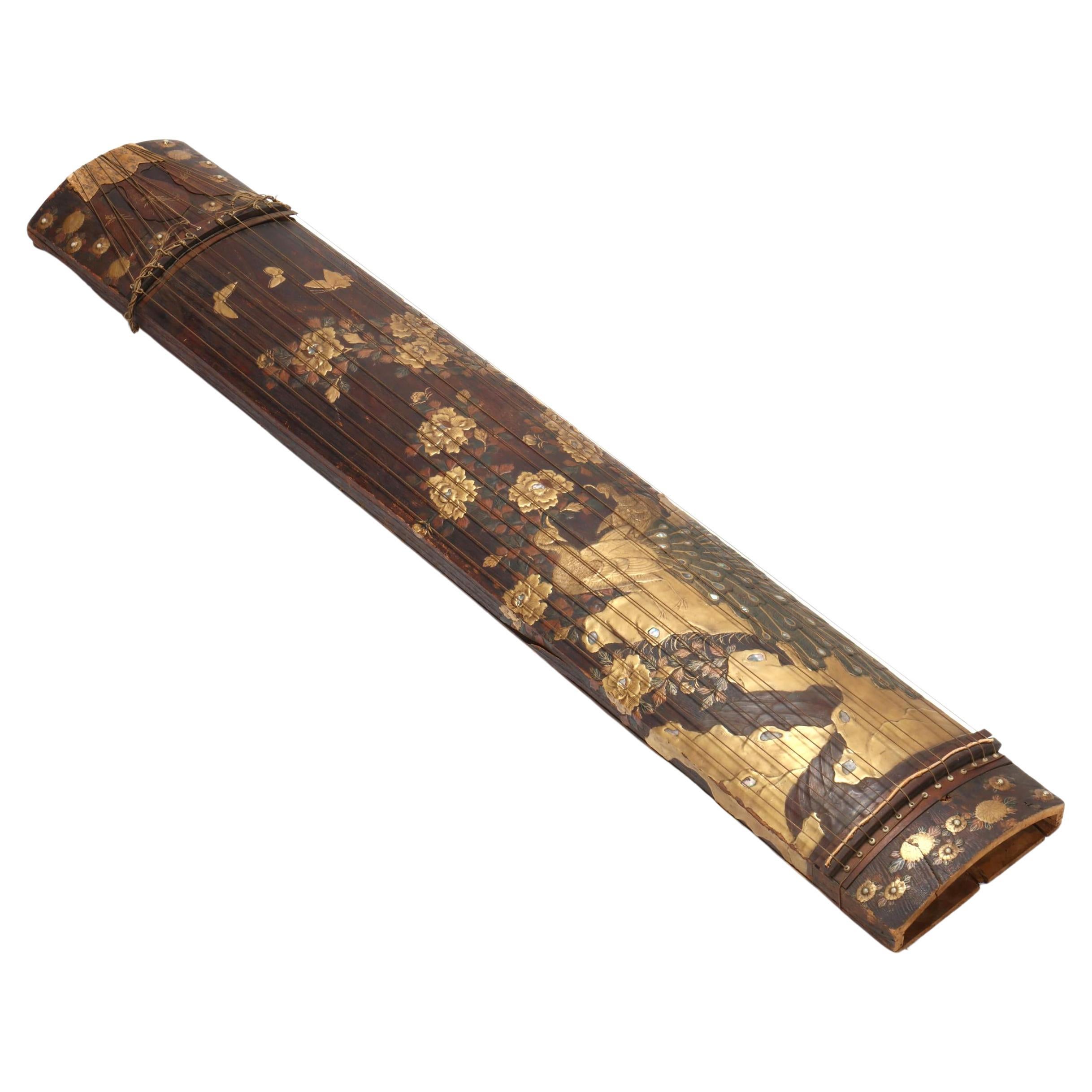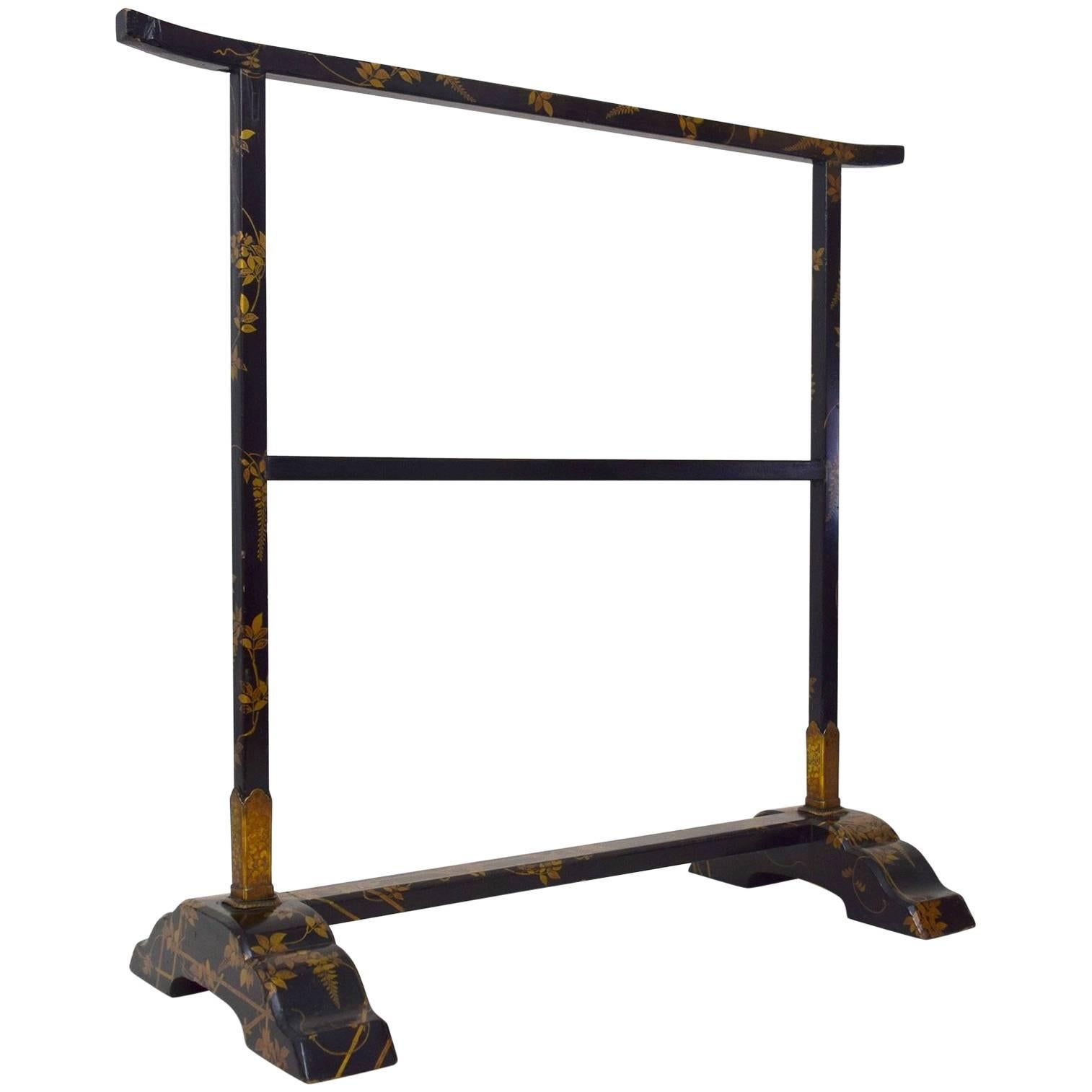Items Similar to Exquisite Japanese Lacquer Maki-e Suzuribako by Koma Kyūhaku Edo Period
Want more images or videos?
Request additional images or videos from the seller
1 of 16
Exquisite Japanese Lacquer Maki-e Suzuribako by Koma Kyūhaku Edo Period
About the Item
One of the finest Japanese Maki-e Suzuribakos (ink box) we have on offer, the roiro color box showcases an ambient nocturnal scene in which two shakudo inlaid crows perched on the handrails of a bridge (possible the Uji Bridge outside of Kyoto) under a cloudy night sky. The ambience continues to the interior under the lid, where a half-hidden silver moon casts a faint shadow over the water, with the banks reinforced by jakago (bamboo baskets filled with stones) highlighted by Radan shell inlays shimmering in the darkness. This imagery may allude to the opening line of a famous Tang Dynasty pome by ZhangXu: The moon is setting among the cries of the crows; the night is covered with autumn frost.
The base of the interior features a raised platform and a frame containing a suzuri (ink stone) with gold fundame rims) and a silver suiteki (water dropper) of in the complementary form of a waterwheel and waves. Under the inkstone, there is signature "Koma Kyuhaku" in gold Maki-e Kanji. Koma Family is a dynasties of lacquer artists started in the 17th century by Kyui I and continues to the beginning of the 19th century. In the eighteenth century, there were six Kyuhaku over the generations that used the same name with the last one Kyuhaku VI died in 1806. It is therefore difficult to know exactly when the piece was made or by whom. It was likely made in 18th century during Edo period.
With a kabusebuta (overhanging lid) and scalloped sumikiri (cut-off corners), the exquisite suzuribako strikes one with its moodiness and delicate but sure-handed composition. The wide range of decorative techniques, including gold hiramaki-e, takamaki-e, and togidashi maki-e with hirame flakes, shakudo, and radan inlays, were used harmoniously and cohesively to achieve the aesthetic vision.
There is a tomobako box in black-painted wood accompanies the suzuribako. It remains a collector's paper sticker with ink Kanji note: "Maki-e Ink box; Bird over bridge, seeing the half-hidden moon from afar. Made by Koma Kyuhaku".
- Dimensions:Height: 2 in (5.08 cm)Width: 9.25 in (23.5 cm)Depth: 10.125 in (25.72 cm)
- Style:Japonisme (Of the Period)
- Materials and Techniques:
- Place of Origin:
- Period:
- Date of Manufacture:Late 18th-Early 19th Century
- Condition:Wear consistent with age and use. Overall fine and attractive condition with some age-related wear and patina and expected minute losses of gold speckles etc. Base shows contact minor contact wear. The tomobako box shows wear.
- Seller Location:Atlanta, GA
- Reference Number:1stDibs: LU945030766252
About the Seller
5.0
Platinum Seller
These expertly vetted sellers are 1stDibs' most experienced sellers and are rated highest by our customers.
Established in 2006
1stDibs seller since 2010
479 sales on 1stDibs
Typical response time: <1 hour
- ShippingRetrieving quote...Ships From: Atlanta, GA
- Return PolicyA return for this item may be initiated within 2 days of delivery.
More From This SellerView All
- Japanese Lacquered Maki-e Fubako Edo PeriodLocated in Atlanta, GAA Japanese lacquered wood fubako (a box used to store document or small scroll painting), circa second half of 19th century late Edo period. The rectangular box features an unusually deep lipped lid with slightly rounded corners, a conforming lower box that is almost entirely covered by the lid which has two bronze medallion rings with tasseled...Category
Antique 19th Century Japanese Edo Lacquer
MaterialsWood, Lacquer
- Japanese Lacquer Tray with Maki-e and Inlay Hara Yoyusai Edo PeriodLocated in Atlanta, GAA lovely Japanese lacquer rectangular lacquer tray with a slightly scalloped corner and four L shape supporting feet by one of the most celebrated lacquer artist active in Edo period Hara Yoyusai (1772-1845). Yoyusai lived in Edo (Tokyo) and worked under the patronage of Lord Matsudaira. He operated a large workshop and had a very prolific output of lacquer objects. Most survived pieces being inro...Category
Antique 19th Century Japanese Japonisme Lacquer
MaterialsWood, Lacquer
- Japanese Lacquered Gold Maki-E Naga Fubako Meiji PeriodLocated in Atlanta, GAA Japanese lacquered wood Naga Fubako (a long box used to store document or large scroll painting), circa 19th century Meiji period. The rectangular box features an unusually deep lipped lid with slightly rounded corners, a conforming lower box with bronze medallion rings with tasseled...Category
Antique 19th Century Japanese Meiji Lacquer
MaterialsWood, Lacquer
- Japanese Meiji Han Koto with Maki-e Lacquer DecorationLocated in Atlanta, GAA rare Japanese Koto made from carved Paulownia wood and lavishly decorated with lacquer Maki-e circa late 19th century of Meiji Period (1868-1912). The ...Category
Antique Late 19th Century Japanese Japonisme Lacquer
MaterialsWood
- Japanese Lacquered Maki-E Natsume in Kodaiji StyleLocated in Atlanta, GAA Japanese lacquered tea caddy (known as Natsume) with fine Maki-e decoration circa 18-19th century Edo to Meiji period. The large-sized nat...Category
Antique 19th Century Japanese Meiji Lacquer
MaterialsWood, Lacquer
- Japanese Lacquered Maki-E Fubako in Kodaiji StyleLocated in Atlanta, GAA rare Japanese lacquered wood fubako decorated in Kodaiji maki-e style circa early 17th century the beginning of the Edo period, possibly early toward the end of the Azuchi-Momoyama period. The rectangular, long and slim box features a deep lipped lid with slightly rounded corners, a conforming lower box with two bronze medallion rings with tasseled...Category
Antique Early 17th Century Japanese Edo Lacquer
MaterialsWood, Lacquer
You May Also Like
- Elegant Japanese Edo Period RackLocated in New York, NYThis refined object dates to the first half of the 19th century, and was probably used for obi, kimono sashes, which were hung over it. The gold decorations on the black-lacquered g...Category
Antique 1830s Japanese Edo Lacquer
MaterialsLacquer
- Japanese Edo Period Lacquer and Mother-of-Pearl Embellished Stoneware KoroLocated in Austin, TXA highly unusual Japanese crackle glazed koro (incense burner or censer), lacquered and inlaid with mother-of-pearl embellishment, signed Gyokusen, Ed...Category
Antique 19th Century Japanese Edo Scholar's Objects
MaterialsCopper
- Suzuribako decorated with a bird of prey in maki-e, Japan Edo periodLocated in Saverne, Grand EstExceptional suzuribako, the outside of the lid decorated with a bird of prey attached to its perch, the inside decorated with an old cherry tree in blossom behind faggots. The interi...Category
Antique 18th Century Japanese Edo Lacquer
MaterialsWood
- Japanese Lacquer Hibachi with Imperial Chrysanthemum, Meiji Period, JapanLocated in Austin, TXA simple and elegant Japanese lacquer hibachi stand with imperial chrysanthemum mon and copper liner, now modified as an usubata, late Meiji Period, ci...Category
Antique Early 1900s Lacquer
MaterialsCopper
- Japanese Lacquer Stationery Box, Suzuribako, Edo Period, 19th c, JapanLocated in Austin, TXA fine and elegant Japanese lacquer box for writing implements or stationery, suzuribako, with an image of a Shinto shrine, Edo Period, mid-19th century, circa 1840, Japan. The exqu...Category
Antique Mid-19th Century Japanese Edo Lacquer
MaterialsGold Leaf
- Japanese Lacquer Writing Box, Suzuribako, Edo Period, 18th Century, JapanLocated in Austin, TXAn exceptionally fine and unusual Japanese lacquer writing implements box, suzuribako, in the form of a zither, koto, Edo Period, 18th century, Japan. With a modern wood storage box,...Category
Antique 18th Century Japanese Edo Lacquer
MaterialsGold, Silver, Copper
Recently Viewed
View AllMore Ways To Browse
Lacquered Base
Lacquer Black Frame
Lacquered And Painted Wood
Black Lacquered Painted
Black Gold Lacquer
Stone Japan
Japanese Stone
Gold And Black Lacquer
Black Lacquer Decorative
Lacquered Bamboo
Lacquered Bamboo Furniture
Japanese Stone Art
Antique Collectors And Period Furniture
Asian Ink Art
Wood Lacquered Box
Inlaid Lacquer
Edo Wood
Japanese Black Stone
